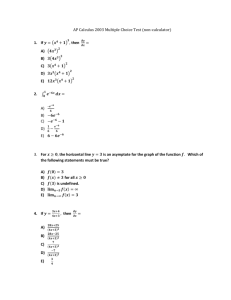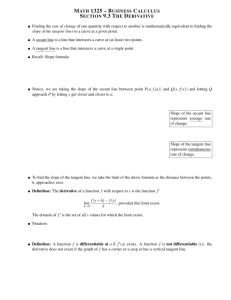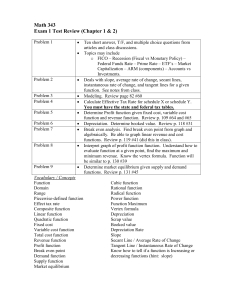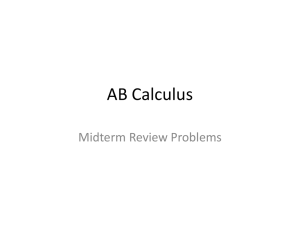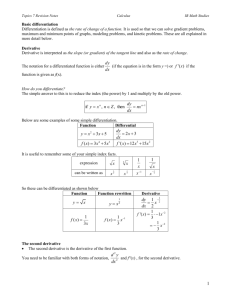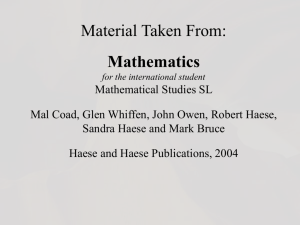Intro to Derivatives
advertisement
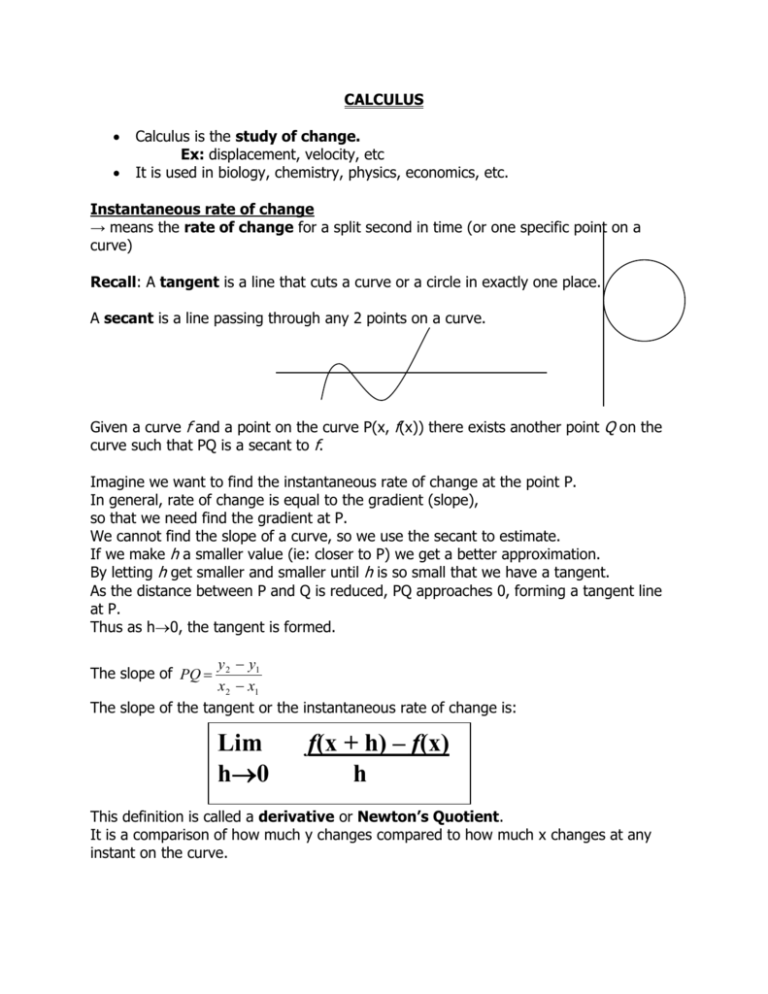
CALCULUS Calculus is the study of change. Ex: displacement, velocity, etc It is used in biology, chemistry, physics, economics, etc. Instantaneous rate of change → means the rate of change for a split second in time (or one specific point on a curve) Recall: A tangent is a line that cuts a curve or a circle in exactly one place. A secant is a line passing through any 2 points on a curve. Given a curve f and a point on the curve P(x, f(x)) there exists another point Q on the curve such that PQ is a secant to f. Imagine we want to find the instantaneous rate of change at the point P. In general, rate of change is equal to the gradient (slope), so that we need find the gradient at P. We cannot find the slope of a curve, so we use the secant to estimate. If we make h a smaller value (ie: closer to P) we get a better approximation. By letting h get smaller and smaller until h is so small that we have a tangent. As the distance between P and Q is reduced, PQ approaches 0, forming a tangent line at P. Thus as h0, the tangent is formed. y 2 y1 x 2 x1 The slope of the tangent or the instantaneous rate of change is: The slope of PQ Lim h0 f(x + h) – f(x) h This definition is called a derivative or Newton’s Quotient. It is a comparison of how much y changes compared to how much x changes at any instant on the curve. A derivative represents the slope of the tangent at a given point. Ex: Find the instantaneous rate of change for the curve f(x) = x2 at the point x = 2 Slope = Lim h0 f(x + h) – f(x) h Ex: Calculate the derivative of f(x) = 3x2 – 6x + 4 at x = 1. Ex: Find the equation of the tangent to f(x) = x3 – 1 at the point x = -2. Ex: Find the derivative of y = x3 + x. DIFFERENTIATION Differentiation is the process of finding a derivative The derivative of a function at a point, f(x), is the gradient of the tangent line at that point. Notation: 1. f `(x) → “f prime of x” 2. y` → “y prime” or “f dash of x” 3. dy → Leibniz notation dx →“the derivative of y in terms of x” → read as “d y d x” 4. d → read as “d d x” dx Differentiation rules We can use Newton’s Quotient to find a derivative, but it takes too long. There are a few rules to help! 1. The Constant Rule If f(x) = c (where c is any constant), then f `(x) = 0 Ex: f(x) = 2 dy = 0 dx A constant is a horizontal line. Any tangent would lie directly on top of it. The slope of a horizontal line is always 0. 2. The Power Rule If f(x) = xn, then f `(x) = nxn-1. (In plain English, bring the exponent down in front and reduce the new exponent by 1.) Ex: 1. f(x) = x2 dy = dx f `(x) = 2. f(x) x100 3. f(x) = 1 x3 d= dx 3. The Constant Multiple Rule If f(x) = kg(x), then f `(x) = k(g`(x)). Ex: f(x) = 8x3 f `(x) = Ex: g(x) = -3x15 g`(x) = 4. The Sum and Difference Rule If f(x) = g(x) + h(x), then f `(x) = g`(x) + h`(x) If f(x) = g(x) - h(x), then f `(x) = g`(x) - h`(x) Ex: a) f(x) = 2x2 + 3x b) c) f(x) = 7x3 – 5x2 + 3x – 2 f `(x) = y = 4x - x2 + 1 f `(x) = y`= Application: Determine the coordinate(s) on the curve x:→x3 – x + 2 where the gradient is 11. BE SMART! Questions like y = (3x2)4 and f(x) = (x – 3)2 is must be put in power form before you take the derivative If it is easier to multiply out the expression – save yourself some precious seconds!! NATURAL LOG DERIVATIVES Dx ex = ex
